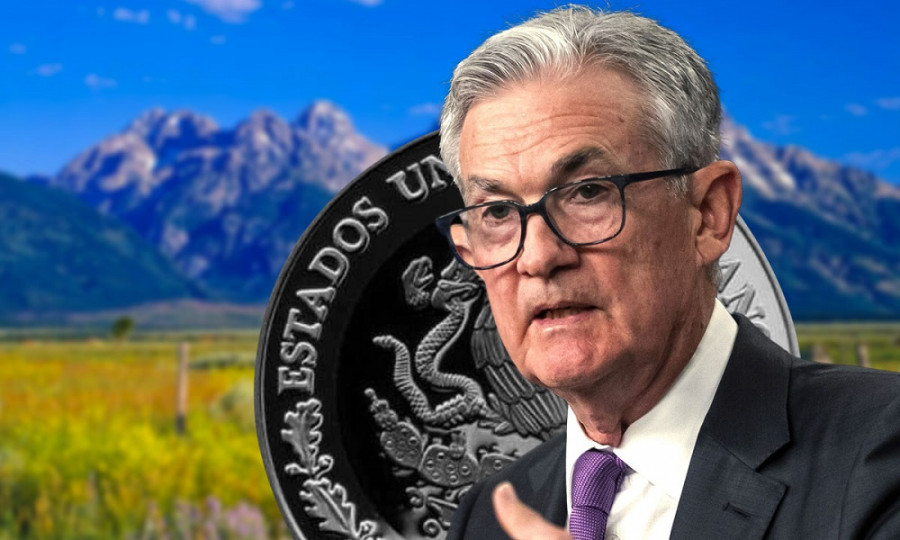
What position will Federal Reserve Chairman Jerome Powell take today when speaking at the economic symposium in Jackson Hole? The question isn't trivial, as the fate of the greenback, and consequently, the EUR/USD pair, depends on his answer. The Fed Chairman will either strengthen the greenback or weaken it, "reconfiguring" the layout of the main major currency pairs. On the eve of this week's key event (and perhaps of the month), the U.S. currency surged: the U.S. dollar index jumped to 104.25, and the EUR/USD pair dipped to the 7th figure for the first time since early June. Weak indices from the German IFO Institute provided additional support to the pair's sellers, allowing the bears to reach 1.0767.

However, in this context, the IFO indices play merely a supporting role: the greenback is driving the decline. It's important to note that such impulsive movements, especially on the eve of significant events (and not after the fact), are always a cause for concern. Dollar bulls are betting on hawkish expectations, playing out an event that hasn't occurred yet. This is the classic case of buying the dollar on rumors. And it's crucial to remember the trading principle that they often "sell on the news" afterward. Now, Powell will have to work hard to amplify the hawkish effect of his speech and support the dollar. And since he often tries to voice a balanced rhetoric, using "vague" or double-edged phrases, the risk of an upward pullback after such a sharp impulsive drop in EUR/USD is quite significant.
One could agree that there are some precursors to Powell tightening his rhetoric. Contradictory inflation reports published in the U.S. over the past few weeks have reignited the debate about potential actions by the Fed in the remaining meetings this year. In this situation, there are two sides to the coin, and Powell might well "highlight" one of them.
On the one hand, the overall U.S. Consumer Price Index, for the first time since June of the previous year, showed an upward trend after a 12-month consecutive decline. The indicator came out at 3.2%, with forecast of 3.3%. The Producer Price Index, which components have moved into the "green zone" for the first time in the past year, is also on the dollar's side. Specifically, the overall CPI on an annual basis increased by 0.8%, with a growth forecast of 0.3%. The indicator had been declining consecutively for 12 months but unexpectedly rose in July. Also in favor of the greenback were the wage indicators from the Nonfarm Payrolls. The average hourly wage rate increased in July by 4.4% year-on-year, while experts expected it to fall to 4.1%. The indicator has been at the 4.4% mark for the fourth consecutive month.
That's one side of the coin, so to speak—the obverse. But there's also the reverse.
On the other hand, the core consumer price index came in at 4.7% (with a forecast of 4.8%), which suggests a downward trend—the index has been decreasing year-on-year for four consecutive months, reaching its lowest value in July since November 2021. At the end of July, the core PCE index (crucial for the Federal Reserve's inflation indicator) also showed a downward trend, dropping to 4.1%—the weakest growth rate of the indicator since October 2021.
Given such a contradictory picture, Powell might choose to emphasize certain points—either expressing concern about the acceleration of some inflation indicators or worrying about the side effects of strict monetary policy (particularly in the banking sector).
According to the CME FedWatch Tool, the probability of a 25-point rate hike at the end of the September meeting increased to 20% (earlier this month, this probability was around 8–9%). As for the prospects of the November meeting, market participants estimate the likelihood of a 25-point increase (assuming the status quo is maintained in September) at 45%. Jerome Powell's rhetoric could either strengthen or weaken these hawkish expectations.
It's also important to note another point. This week, two Federal Reserve representatives stated that the moment "when rates can be held at their current level" has probably been reached. This position was voiced by the Boston Fed's Susan Collins (who doesn't have voting rights this year) and Philadelphia Fed's Patrick Harker (who does). Earlier, several of their colleagues (including New York Fed's John Williams) considered the option of lowering the interest rate in the first half of 2024.
If the Fed Chair refutes such intentions, the dollar will experience increased demand. However, if he agrees with these dovish conclusions/perspectives, the greenback will be under substantial pressure, especially against today's false start by dollar bulls.
In conclusion, based on the above, one can infer that Powell's speech today will undoubtedly provoke increased volatility in the EUR/USD pair—the Fed Chair will either strengthen the downward momentum (if he surprises traders with a distinctly hawkish stance) or trigger a significant upward correction (if he is cautious in his rhetoric and/or allows a pause in the upcoming meetings). It's clear that in such uncertain conditions, it's advisable to stay out of the market, including for the EUR/USD pair.